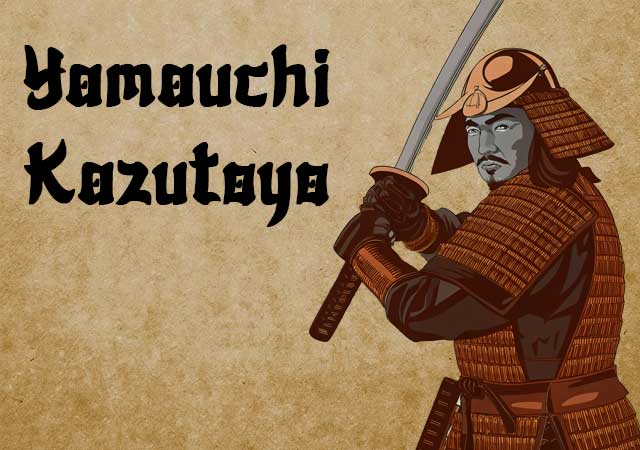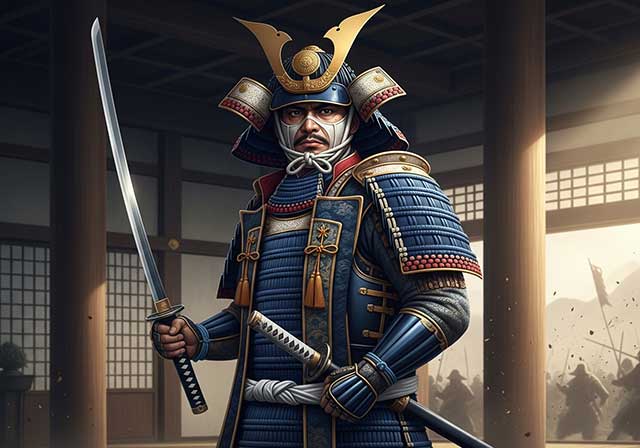
Yamauchi Kazutoyo (also spelled Yamanouchi; 1545/1546? – November 1, 1605) was a prominent samurai and retainer who served Oda Nobunaga and later Toyotomi Hideyoshi during Japan's Sengoku and Azuchi-Momoyama periods. His father, Yamauchi Moritoyo, was a descendant of Fujiwara no Hidesato and a senior retainer of the Iwakura Oda clan, which opposed Oda Nobunaga. Moritoyo was also the lord of Kuroda Castle in Owari Province. Kazutoyo is especially renowned for his marriage to Yamauchi Chiyo, whose wisdom and resourcefulness played a key role in his rise to prominence.
Early Life and Service
Kazutoyo began his career as a 400-koku samurai and gained recognition as a capable leader and mentor. Notable figures such as Kuroda Nagamasa, who was a hostage of Oda Nobunaga, and Toyotomi Hidetsugu were entrusted to him for guidance. He fought on the Oda side in the Battle of Anegawa in 1570, showcasing his loyalty and martial prowess.
Rise to Power
After the Siege of Odawara in 1590, Toyotomi Hideyoshi rose to power, and Kazutoyo was granted control of Kakegawa Castle. During this period, Tokugawa Ieyasu was relocated from the Tōkai region to the Kantō region, consolidating power under Hideyoshi's regime.
The Battle of Sekigahara and Tosa Domain
Kazutoyo sided with Tokugawa Ieyasu during the pivotal Battle of Sekigahara in 1600, a victory that solidified the Tokugawa shogunate. Following the battle, Kazutoyo was rewarded with the province of Tosa, where he constructed Kochi Castle and was granted the title *Tosa no kami*. This marked the pinnacle of his career, as he transitioned from a minor samurai to the lord of an entire province.
Later Life and Legacy
Kazutoyo passed away in 1605, just four years after becoming the Lord of Tosa. He died without direct heirs and was succeeded by his nephew, Tadayoshi. Despite his relatively short tenure as a provincial lord, Kazutoyo’s legacy is intertwined with his wife Chiyo, whose strategic insight and unwavering support were instrumental in his success.
Cultural Depiction
Kazutoyo’s life and his marriage to Chiyo inspired the 45th NHK Taiga drama, "Komyo ga Tsuji" (2006). The series, based on a story by Shiba Ryotaro, portrays Chiyo as the central character and highlights her pivotal role in Kazutoyo’s rise. Nakama Yukie starred as Chiyo, with Takaya Kamikawa portraying Kazutoyo. The drama captured the couple’s journey from modest beginnings to ruling the Tosa domain, emphasizing themes of loyalty, perseverance, and partnership.
See also
-
Uemura Masakatsu

Masakatsu was a member of the Uemura clan and the son of Uemura Masatada; from an early age he served Tokugawa Ieyasu. During the Ikkō-ikki uprising in Mikawa Province in 1563, having converted from the Jōdo Shinshū Buddhist sect to the Jōdoshū sect, he took part in suppressing the rebels. After these events, Masakatsu was appointed a military governor and was granted land holdings. According to a number of sources, he was one of the so-called “Three Governors of Mikawa” (Mikawa sanbugyō), together with Amano Yasukage (1537–1613) and Koriki Kiyonaga (1530–1608).
-
Tomoe Gozen

Gozen is regarded as one of the few historically documented examples of true female warriors of feudal Japan, known as onna-musha or onna-bugeisha. Although Japanese history records countless women who at various times were forced to take up arms—for example, in defense of their castles—Tomoe Gozen was, without any doubt, a genuinely skilled and accomplished fighter. She was the wife of Kiso (Minamoto) Yoshinaka, although The Tale of the Heike describes her more as a female vassal. Yoshinaka rose in rebellion against the Taira clan and, in 1184, captured Kyoto after his victory at the Battle of Kurikawa. After the Taira were driven into the western provinces, Yoshinaka began insistently asserting that he alone was worthy of assuming leadership of the Minamoto clan and taking on the mantle of its head.
-
Tachibana Muneshige

Tachibana Muneshige was born the eldest son of Takahashi Shigetane, one of the principal retainers of the Ōtomo clan and commander of Iwaya Castle. In childhood, he bore the name Senkumamaru. His early years coincided with a period of intense military confrontation between the Ōtomo clan and other powerful warrior houses of Kyūshū—namely the Shimazu, Akizuki, and Ryūzōji clans.
-
Tachibana Dosetsu

Tachibana Dōsetsu is the name by which Hetsugi Akitsura is more widely known; the name of this lineage is also found read as Hekki or Bekki. For a long period, Akitsura served the Ōtomo clan, the daimyō of Bungo Province, and took part in wars against the Ōuchi family, the principal enemies of the Ōtomo in northwestern Kyushu. In the 1560s, Akitsura seized the castle of the Tachibana clan, which had rebelled against the Ōtomo, and thereafter adopted the surname Tachibana. Around the same time, he took Buddhist vows and assumed the name Dōsetsu, which means “Snowy Road.”
-
Taira no Masakado

Taira no Masakado embodied the quintessential samurai of his era—self-assured, harsh, and unyielding. In his youth, he served in the palace guard and repeatedly proved his bravery while suppressing unrest. Thanks to these achievements, Masakado sought the post of chief of the capital’s military-police office (the kebiishi-chō), but he was rejected: by that time, nearly all court positions—now little more than privileged sinecures—were controlled by members of the powerful Fujiwara clan.
-
Sakakibara Yasumasa

Yasumasa was the second son of Sakakibara Nagamasa and was born in Ueno in Mikawa Province. From a young age, he began serving Tokugawa Ieyasu and eventually rose to the position of one of his most trusted generals. His wife was the daughter of Osuga Yasutaka. Ieyasu first noticed the young Yasumasa during the suppression of the Ikkō-ikki uprising in Mikawa in 1564. Thanks to his demonstrated abilities, Yasumasa was granted the privilege of using the character “yasu”—the second character of Ieyasu’s own name—in his own. Although he was the second child in his family, he became his father’s heir, though the exact reasons for this remain unknown.
-
Sakai Tadatsugu

Tadatsugu was one of the most renowned generals serving Tokugawa Ieyasu. After Ieyasu broke ties with the Imagawa clan, Tadatsugu—an ardent supporter of this decision—was granted command of Yoshida Castle in 1565, which controlled the coastal road from Tōtomi to Mikawa. During the Battle of Mikatagahara in 1573, he held the right flank of the Tokugawa forces even when the troops sent by Oda fled under the assault of the Takeda army. In the Battle of Nagashino in 1575, he personally requested permission to carry out a night attack on the Takeda camp, which he executed brilliantly together with Kanamori Nagachika.
-
Ryuzoji Takanobu

Takanobu was the eldest son of Ryūzōji Takaie and the great-grandson of Ryūzōji Iekane. His father was killed by a man named Baba Yoritiku in 1544. At a young age, Takanobu took Buddhist vows and received the monastic name Engetsu. However, around the age of eighteen, he returned to secular life, and in 1548, after the death of Ryūzōji Tanehide, he became the head of both branches of the Ryūzōji family.

